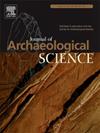探讨铼锇同位素体系及铁物源的金属微量元素分析
IF 2.6
1区 地球科学
Q1 ANTHROPOLOGY
引用次数: 0
摘要
尽管关注古代铁的来源的项目在考古冶金研究中变得越来越普遍,但目前还没有标准化的方法。近年来的研究表明,锇(187Os/188Os)同位素分析是一种可靠而有效的方法。研究还表明,金属相的微量元素组成分析为完善考古铁的起源假设提供了补充指纹,并克服了同位素特征的重叠。本研究进一步探讨了铼锇同位素系统和187Re/188Os同位素比值作为鉴别矿源的附加参数的潜力。本文章由计算机程序翻译,如有差异,请以英文原文为准。
Exploring the rhenium-osmium isotopic system and metal trace-elements analysis for iron provenance
Although programs focusing on the provenance of ancient iron are becoming more common in archaeometallurgical research, no standardised approach currently exists. Recent studies have shown the potential of osmium (187Os/188Os) isotope analysis as a robust and effective method. It was also shown that trace element composition analysis, of the metal phase, provides a complementary fingerprint to refine hypotheses about the origins of archaeological iron, and to overcome the overlapping of isotopic signatures. This study further explores the potential of the rhenium-osmium isotope system and the 187Re/188Os isotope ratio as an additional parameter for distinguishing ore sources.
By analysing metallurgical products smelted experimentally, this research utilises the residual solutions from Os and Re isotope analysis (conducted via Carius tube digestion) to directly determine the concentrations of 12 trace elements within the metal phase (Cr, V, Co, Ni, Mo, Cu, As, Sb, Sn, Zn, W, Pb) using solution inductively coupled plasma mass spectrometry (ICP-MS). The study also qualitatively compares the efficiency of this method against results obtained by laser ablation ICP-MS analyses of polished blocks. Findings demonstrate that the new method offers better comparability with Os and Re concentrations. Moreover, the study identifies two siderophile (Co, Ni) and four chalcophile elements (Mo, Cu, As, Sb) that exhibit near-complete reduction from ore to metal in the bloomery process while also highlighting the potential of the 187Re/188Os isotope ratio for distinguishing ore sources. Thus, the study enhances the potential for large-scale diachronic and synchronic investigations of ancient iron artifacts, providing critical insights into metallurgical practices and their socio-economic and political contexts.
求助全文
通过发布文献求助,成功后即可免费获取论文全文。
去求助
来源期刊

Journal of Archaeological Science
地学-地球科学综合
CiteScore
6.10
自引率
7.10%
发文量
112
审稿时长
49 days
期刊介绍:
The Journal of Archaeological Science is aimed at archaeologists and scientists with particular interests in advancing the development and application of scientific techniques and methodologies to all areas of archaeology. This established monthly journal publishes focus articles, original research papers and major review articles, of wide archaeological significance. The journal provides an international forum for archaeologists and scientists from widely different scientific backgrounds who share a common interest in developing and applying scientific methods to inform major debates through improving the quality and reliability of scientific information derived from archaeological research.
 求助内容:
求助内容: 应助结果提醒方式:
应助结果提醒方式:


